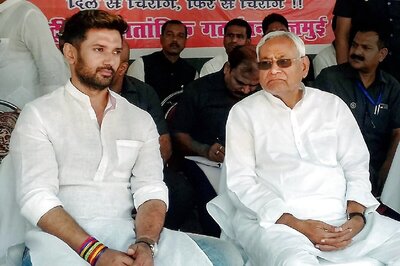
views
New Delhi: Despite the sweltering heat in almost every region of Rajasthan, the desert state recorded an overall high voter turnout of 68.17% in its first phase of polling in the 13 Lok Sabha seats on April 29.
Barmer, which saw the mercury reach as high as 44°C, recorded the highest polling at 73.12% in the state, while Pali registered the lowest voter turnout at 62.37%.
Banswara and Chittorgarh seats also witnessed high voter turnouts at 72.81% and 72.16%, respectively.
Jhalawar-Baran, a BJP stronghold and has elected Dushyant Singh, son of former CM Vasundhara Raje, to Parliament for three consecutive terms, also witnessed high polling at 71.94%.
Rajasthan’s Chief Electoral Officer Anand Kumar said his office had taken up various measures to ensure good turnout of voters at polling booths in the state.
“Barmer, anyway, has a history of registering high polling percentage, but some of our activities, wherein we did a lot of work on systematic voter education and electoral participation, also helped,” Kumar, who was on a round of districts that will go to polls on May 6, said.
“Also, we identify regions had lower polling percentage in earlier elections. These booths are then addressed in different ways,” the chief electoral officer said.
According to Kumar, electors are apprised of all voting processes and explained how to navigate through them all.
“We repeatedly appeal to public to vote,” he added.
Rajasthan has added 12 lakh new voters since the 2014 Lok Sabha election.
In fact, in late March, the office of the chief electoral officer had sent a proposal to the Election Commission to add 266 polling booths to the existing 51,965 polling stations in the state because of the increased number of electors, though the EC rejected the suggestion.
“The polling booth numbers are the same as in Assembly elections. We do send such proposals if the number of voters increases. However, since the Lok Sabha election usually see lower polling percentage than during Assembly election, we did not get the permission,” said Kumar, adding, “But we experienced no problem and polling occurred in a proper manner.”
The EC, however, did set up 169 additional polling booths in the desert state ahead of Assembly election in 2018. The additional booths, called auxiliary polling stations, took the total number of polling stations from 51,796 to 51,965. The state had then registered an overall voter turnout of 72.62%.
The increased number of polling booths compared to last general election and efforts of the polling body aside, competitive caste mobilisation has also impacted voter turnout positively, say political analysts in the state.
According to former BBC journalist and political analyst Narayan Bareth, the different communities of the state, Rajputs, Jats, Gujjars, Meenas, among others, are better organised this time around.
With the influx of technology and internet penetration, communication within a community is easier now.
“Whichever seat had a candidate from a particular community, that active community or the communities who were its social allies, campaigned a lot on the seat,” Bareth said.
Caste rivalries too run deep in the state and when caste equations are involved in an election, it becomes a matter of community pride for voters, Bareth said, particularly, in case of castes which have been traditionally hostile to each other.
For example, Jats and Rajputs are considered to be rival communities and have historically voted in contrast to each other.
“In that case, both sides will push hard for their candidate to win,” said Bareth, adding, “They will also involve other communities on their side.”
For instance, in Barmer, which saw the highest turnout in the state, Congress’ Manvendra Singh, a Rajput, was up against Kailash Choudhary, a Jat.
In the neighbouring Jalore, which saw 65.69% polling, BJP’s Devji Mansinghram Patel was up against Ratan Dewasi from the Rebari community.
“Candidates motivate their communities to vote for them and also inspire and invite other communities with whom they have social relations. For example, the Rebari candidate will appeal to members of other Schedule Castes to exercise their franchise in his favour,” Bareth said.
In Chittorgarh, the BJP’s sitting MP Chandra Prakash Joshi, a Brahman, was up against Gopal Singh Idwa, a Rajput. Similarly, in Jodhpur, which saw 68.41% polling, Vaibhav Gehlot, son of Rajasthan CM Ashok Gehlot, was up against BJP’s Gajendra Singh Shekhwat.
While Shekhawat, the sitting MP from the seat, is a Rajput, Gehlot belongs to the Mali community.
In Tonk-Sawaimadhopur, the BJP’s Sukhbir Singh Jaunapuria, a Gujjar, and the Congress’ Namo Narayan Meena, who belongs to the Meena Schedule Tribe, were contesting against each other.
According to Bareth, the Meena candidate would try to mobilise SCs and minorities in his favour.
In Kota, which saw 69.84% polling, the BJP sitting MP Om Birla, a Baniya, was up against the Congress’ Ram Narayan Meena.
In several such seats, rival caste mobilisation on both sides could have resulted in high polling numbers.
Additionally, all parties involved in the state have tried for higher polling numbers this time around.
Also, voter mobilisation has not just occurred across caste lines, but also across age and gender divisions.
In six of the 13 Lok Sabha seats that went to polls on April 29, namely Pali, Barmer, Jalore, Banswara, Udaipur and Rajsamand, women outperformed men voters.
According to a data from the Office of Chief Electoral Officer of Rajasthan, the state also saw 6,06,261 first-time voters in the age group of 18 to 19 years and 24,92,295 voters in the age group of 20-25 years.
According to Bareth, BJP’s national security rhetoric and focus on Balakot airstrikes in its campaigning, encouraged the youth to vote. “The BJP created an atmosphere of nationalism, which impacted the youth in the state and made them active,” he said.




















Comments
0 comment